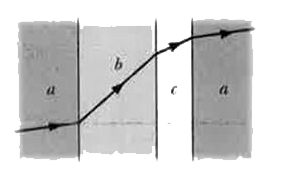The figure shows a monochromatic ray of light traveling across parallel interfaces, from an original material a, through layers of materials b and c, and then back into material a. Rank the materials according to the speed of light in them, greatest first.

b (least n), c, a
Topper's Solved these Questions
- INTERFERENCE AND DIFFRACTION BOOK - RESNICK AND HALLIDAYCHAPTER - INTERFERENCE AND DIFFRACTION EXERCISE - PROBLEMS
61 Videos
- INTERFERENCE AND DIFFRACTION BOOK - RESNICK AND HALLIDAYCHAPTER - INTERFERENCE AND DIFFRACTION EXERCISE - PRACTICE QUESTIONS (Single Correct Choice Type)
66 Videos
- INTERFERENCE AND DIFFRACTION BOOK - RESNICK AND HALLIDAYCHAPTER - INTERFERENCE AND DIFFRACTION EXERCISE - PRACTICE QUESTIONS (Integer Type)
6 Videos
- HYDROGEN ATOMBOOK - RESNICK AND HALLIDAYCHAPTER - HYDROGEN ATOMEXERCISE - PRACTICE QUESTIONS(Integer Type)
6 Videos
- MAGNETIC FIELDS DUE TO CURRENTSBOOK - RESNICK AND HALLIDAYCHAPTER - MAGNETIC FIELDS DUE TO CURRENTSEXERCISE - Practice Question (Integer Type)
4 Videos
Similar Questions
Materials A, B and C are solids that are at their melting temperatures. Material A requires 200 J to melt 4 kg, material B requires 300 J to melt 5 kg, and material C requires 300 J to melt 6 kg. Rank the materials according to their heats of fusion, greatest first.
View SolutionGive three examples of materials that refract light rays. What happens to the speed of light rays when they enter these materials?
View Solution
Knowledge Check
In the following figure gives the stopping voltage V versus the wavelength λ of light for three different materials. Rank the materials according to their work function, greatest first.
 Aϕ3>ϕ2>ϕ1Bϕ1>ϕ2>ϕ3Cϕ2>ϕ3>ϕ1Dϕ3>ϕ1>ϕ2
Aϕ3>ϕ2>ϕ1Bϕ1>ϕ2>ϕ3Cϕ2>ϕ3>ϕ1Dϕ3>ϕ1>ϕ2
The figure shows the face and interface temperatures of a composite slab consisting of four materials, of identical thickness, through which the heat transfer is steady. Rank the materials according to their thermal conductivities, greatest first.

View SolutionWhich materials allow light to pass through them?
View SolutionIn a thermally isolated container, material A of mass m is placed against material B, also of mass m but at higher temperature. When thermal equilibrium is reached, the temperature changes ΔTAandΔTB of A and B are recorded. Then the experiment is repeated, using A with other materials. All of the same mass m. The results are given in the table. Rank the four materials according to their specific heats, greatest first.
ExperimentTemperatureChanges1.ΔTA=+50C∘ΔTB=−50C∘2.ΔTA=+10C∘ΔTC=−20C∘3.ΔTA=+2C∘ΔTD=−40C∘
View SolutionThe diagram shows four slabs of different materials with equal thickness, placed side by side. Heat flows from left to right and the steady-state temperatures of the interfaces are given. Rank the materials according to their thermal conductivities, smallest to largest.

View SolutionThe figure shows refraction of a light ray from a glass. Write the values of angles x and y. what is refractive index of slab material ?

View SolutionA monochromatic beam of light is incident at the interface of two materials of refractive index n1 and n2 as shown . If n1>n2 and θC is the critical angle then which of the following statements is NOT true ?

View SolutionIn figure, light refracts from material 1 to a thin layer of material 2, crosses that layer, and then is incident at the critical angle on the interface between materials 2 and 3.
(a) What is the angle θ?
(b) if θ is decreased, is there refraction of light into material 3?

View Solution
